Okinawan Shoyu Pork is the local Hawaii version of Okinawan dish called Rafute. It's basically braised pork belly. This dish is saucy, sweet and savory...and extra good with rice.
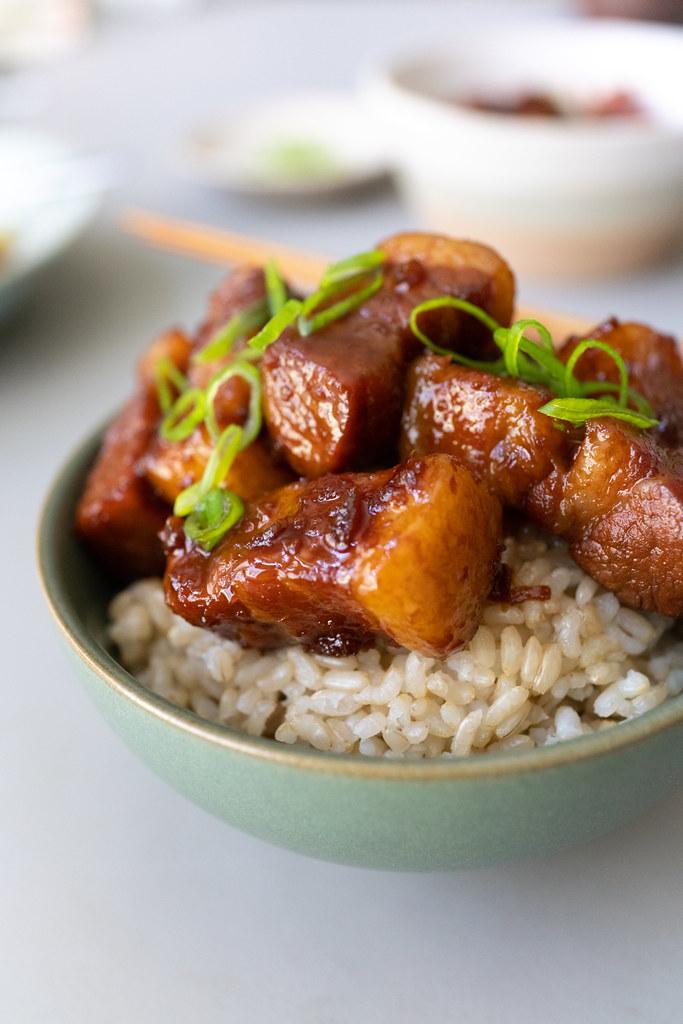
Did you know that Hawaii has really good Okinawan food?
Okinawan Shoyu Pork
Okinawan Shoyu Pork is a deep and flavorful braised pork belly dish. It's rustic and comforting, the definition of good home cooking. You can find this dish at local restaurants in Hawaii, and it is also a popular dish to prepare at home. It's easy to make (a one-pot meal!) and richly satisfying.
Why are we cooking Okinawan food in Hawaii?
Okinawans first migrated to Hawaii in the early 1900s as contract laborers. As with all the different ethnic groups (like Chinese, Japanese, Korean, Filipino) that came to Hawaii, the food from each culture blended/merged to create the food we eat in Hawaii today.
Local Hawaii food (which is different from Hawaiian food), is a true mix of all these cultures.
The different ethnic foods sometimes fuse together to form new dishes (like saimin), and other times, they remain part of their original culture, but adapted for local Hawaii taste buds. Okinawan Shoyu Pork is an example of the latter.
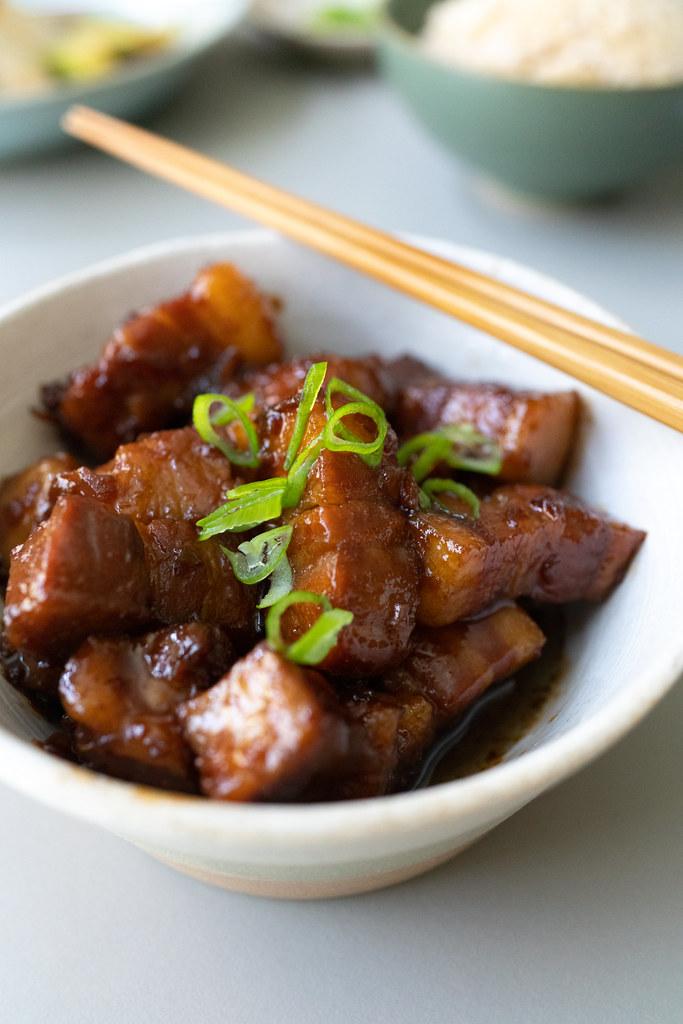
Okinawan Food and Restaurants in Hawaii
There are just a handful of purely Okinawan restaurants in Hawaii. More common are local restaurants that offer a mix of both Japanese and Okinawan dishes. Here are a few we like to visit:
- Hide-Chan Restaurant (Oahu) - Menu is a mix of Japanese and Okinawan dishes. Get the bittermelon tempura and goya champuru, a tofu-egg-bittermelon stirfry (Hide-Chan gives the option of replacing pork with Spam). They serve the rafute/Okinawan shoyu pork with a miso sauce.
- Sunrise Restaurant (Oahu) - Been around forever, super homey and casual. I usually get the Okinawan soba and tofu-pork.
- Teruya's Andagi (Oahu) - Mostly bentos, and wonderful andagi (which is an Okinawan doughnut). Go early to get andagi (and sweet potato mochi) hot from the fryer. Andagi is best devoured hot, and on the spot.
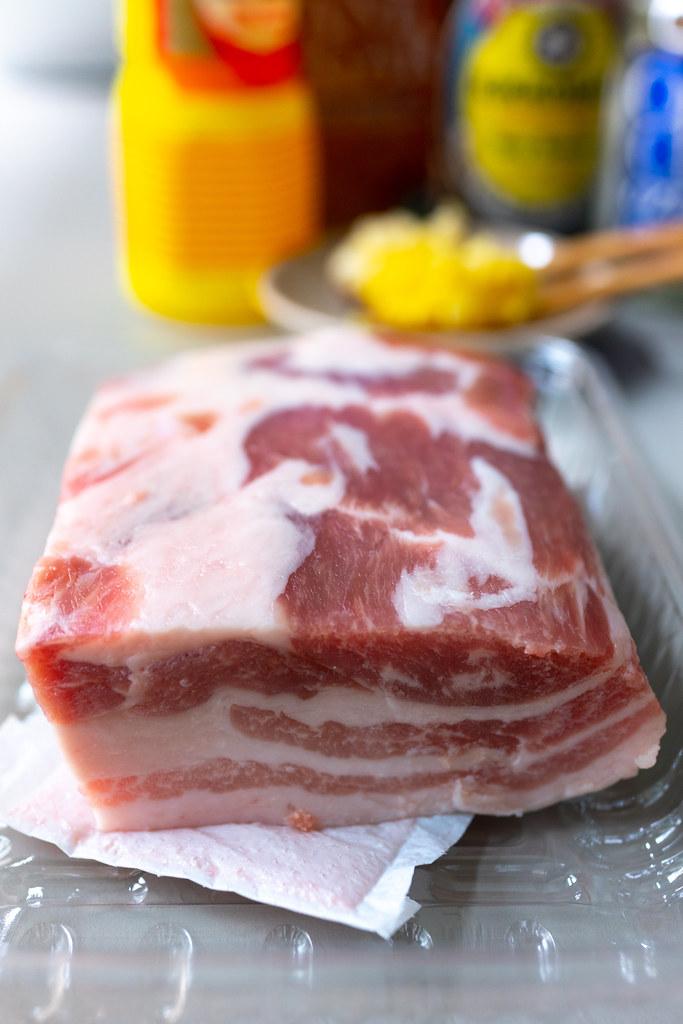
Rafute Versus Okinawan Shoyu Pork
In Hawaii we call this dish, Okinawan Shoyu Pork. In Okinawa, this dish is called Rafute.
The Hawaii version features easier to find ingredients. Hawaii's cooking method is also simplified. Here are the differences:
- Hawaii version uses brown sugar. Okinawa version uses Okinawan black sugar (also called kokuto).
- Hawaii version uses sake. Okinawa version uses Awamori (a 50% proof rice liquor).
- Hawaii version uses water or chicken broth. Okinawa version uses dashi.
- Hawaii version is more simplified/fewer steps (just cube, sear, and then simmer the pork belly in the same pot with all the seasoning ingredients). Okinawa version calls for first boiling the entire pork belly slab, cooling, then cubing, and then putting the pork belly back in the pot to cook with all the seasoning ingredients.
I've made both Rafute and Okinawan Shoyu Pork, and they are both delicious. The ingredients and method varies slightly, but the end result for both is a comforting braised pork belly that is equal parts saucy, savory and sweet.
Cooking it for a long period on low heat yields a ridiculously tender (melt in your mouth!) pork that needs a huge bowl of hot rice.
It's rich but not excessively fatty or indulgent (much of the fat renders out during cooking), it's just very delicious.
"Shoyu" Not "Soy Sauce"
We call it Okinawan Shoyu Pork instead of Okinawan Soy Sauce Pork. In Hawaii, because we refer to soy sauce by it's Japanese name, shoyu.
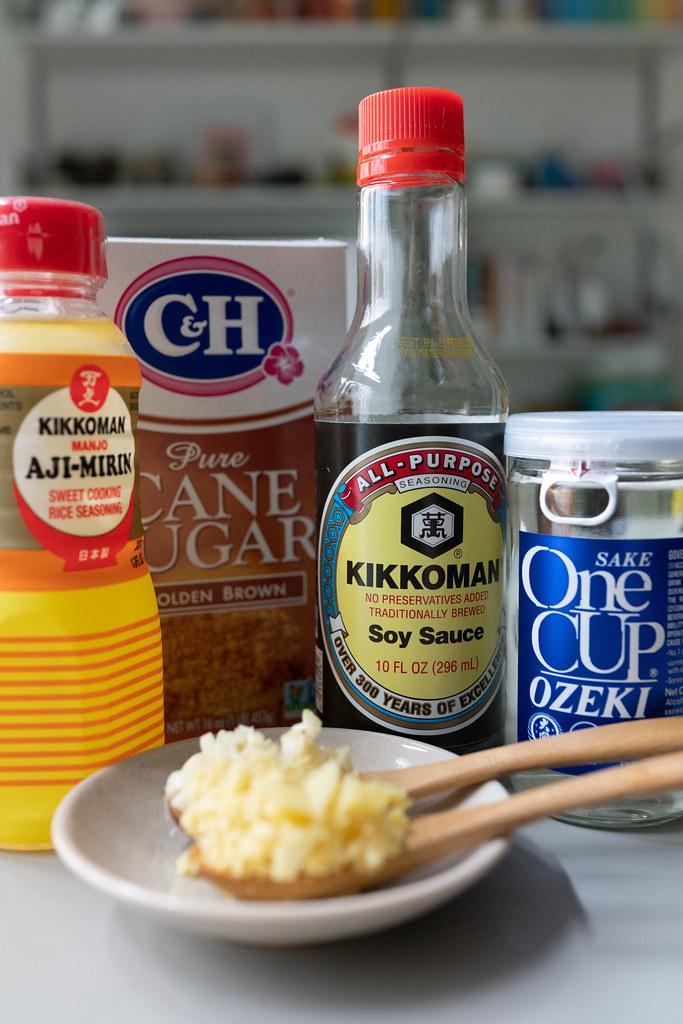
Okinawan Shoyu Pork Method
First, gather your ingredients:
- Pork belly - We usually go to Chinatown or a Japanese market for pork belly. You can buy it as one large piece and cut it at home. Some markets also sell it pre-cut. When on the mainland I go to Japanese markets like Nijiya, Mitsuwa, or Sunrise Mart.
- Garlic - Feel free to use more.
- Ginger - Feel free to use more.
- Water - Or chicken broth.
- Soy sauce
- Sake - Can substitute shochu or chicken broth.
- Brown sugar
- Mirin
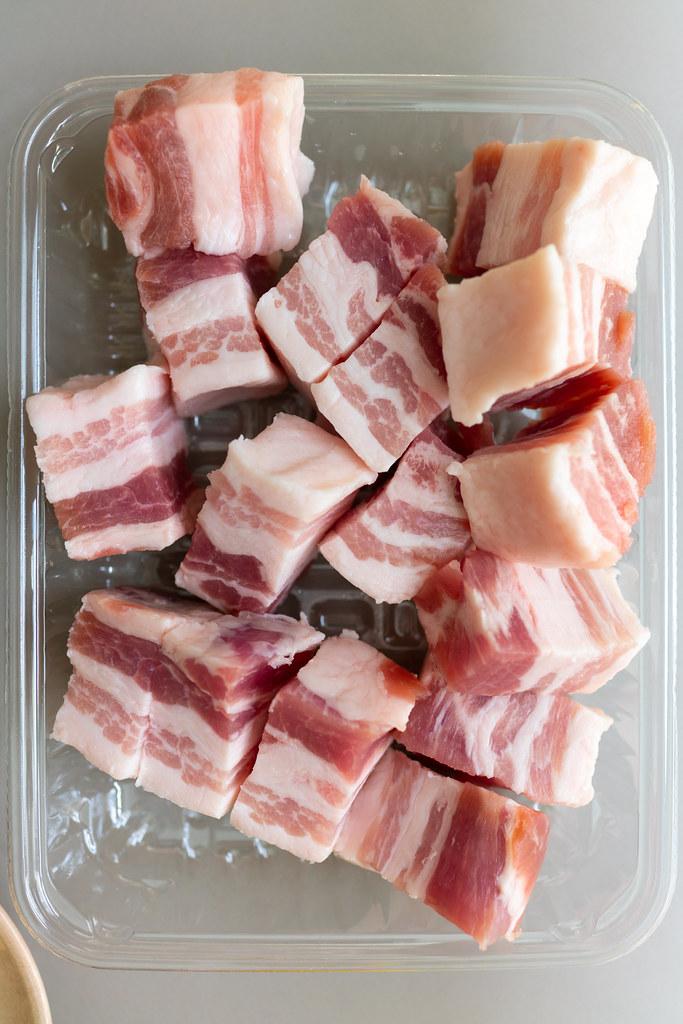
Now we start cooking!
The first thing to do is brown the pork belly on all four sides. Get it a deep, golden brown...this makes the final dish significantly more flavorful.
Then slide in the garlic and ginger. Use a wooden spatula to mix it with the pork belly so that the belly is sort of "coated" in all the garlic and ginger.
Saute everything for another minute, just until the garlic and ginger starts to smell fragrant.
Now pour in everything else. The water, soy sauce, sake, brown sugar, and mirin. Mix and bring to a boil. Once it boils, put a lid on on the pot and turn the heat to low. Let this dish simmer for the next hour and a half.
This is the braising part of the recipe. Cooking it low and slow makes everything so tender. I like to check on the pot every 20 minutes, and give it a stir so that everything cooks evenly.
You can tell the pork is ready when you can pierce it pretty easily with a fork. At this point you should still have some liquid left in the pot. Now we are going to reduce that liquid to a thicker sauce.
Take off the lid. Turn heat to medium-high. The liquid will start bubbling and quickly reduce. Keep reducing the liquid until it's thicker and sauce-y. Then pour everything out into a bowl. Eat with rice!
P.S. This is pretty flavorful dish so I like something simple and green on the side. Sautéed bok choy or spinach with garlic is our go-to side dish for this recipe.
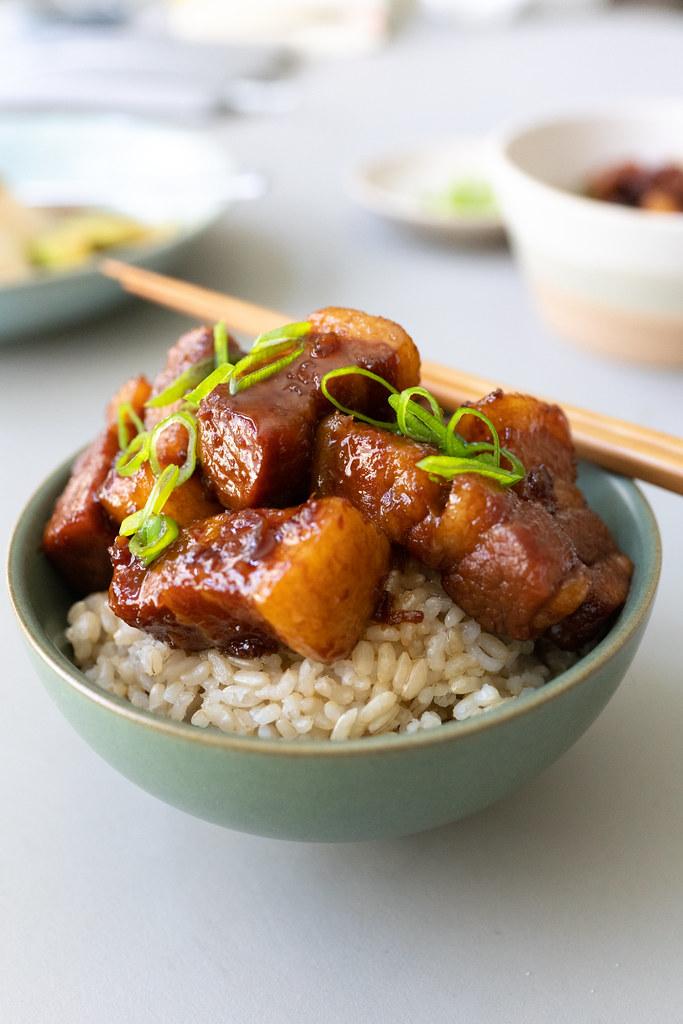
Substitutions
- Replace sake with shochu. For a no-alcohol option, use chicken broth.
- You can use skin-on or skin-off pork belly. Both will come out great. Just make sure it's pork belly.
- I cut into 1-inch cubes, but you can do larger cubes (just increase the cooking time accordingly).
- Instead of mincing, you can use crushed/smashed ginger and garlic. I mince because I like it how the minced bits cling to the pork. Also! That way I don't feel like I'm "wasting" the ginger and garlic because we eat it all.
Tips
- Brown the pork belly well on all sides. This makes a difference in the final dish....gives it so much more flavor.
- 1 pound of pork belly makes enough for a simple, small lunch for two. If you want a bigger meal, leftovers, or have more than 1-2 people, please double the recipe. The leftovers keep well (steam or microwave to reheat).
- 1 pound of pork belly is not a ton of meat, so I'm able to make this recipe in a small pot (like the same pot we use to make instant ramen heheh). If you're using a big pot or cooking in an Instant Pot (instructions below), you'll definitely want to double the recipe.
- My soy sauce measurements are based off the commonly found Kikkoman soy sauce. Some brands of soy sauce are more salty than others. Err on the side of using just a bit less soy sauce if this is a concern.
FAQ
Yes! Instant Pot instructions are in the recipe card below.
I double or triple the recipe when making it in the Instant Pot. One pound of pork belly isn't very much, and we have one of the large Instant Pots.
I love to add eggs to this dish! It reminds me of Chinese braised pork and egg dishes.
While the pork belly is cooking, prepare hard boiled eggs in a separate pot. I like 3 eggs for every 1 pound of pork belly. Let the eggs cool. Peel the shell, and set aside.
Once the pork belly is done cooking, use tongs to transfer the pork belly pieces to a bowl. Add the peeled eggs to the pot with the sauce. Cook over medium heat for 10-15 minutes until the eggs take on all that sauce.
Add the pork belly back to the pot and continue to cook until the sauce reduces to a nice glaze.
Either way is good! Skin-off pork belly seem more common at supermarkets. But if I see skin-on pork belly, I will definitely get that instead.
Depends who you ask! My parents like to eat a little healthier when possible, so I drain off the pork fat after browning.
When making it for myself, I drain off some of the pork fat...but like to keep some far for flavor. Do what feels best for you.
Okinawan Shoyu Pork Recipe
Recipe below ^_^

Okinawan Shoyu Pork
Ingredients
- 1 pound pork belly cut into 1-inch cubes
- 3 garlic cloves minced
- 1- inch knob of ginger minced
- ¼ cup water
- ¼ cup soy sauce
- ¼ cup sake
- 3 tablespoons brown sugar
- 1 tablespoon mirin
Instructions
Stovetop / Regular Pot Instructions:
- In a pot, over medium-high heat, brown the pork belly on all sides. This should take about 5-minutes.
- Add the garlic and ginger to the pot. Mix and saute for another minute till the garlic and ginger is fragrant. Then add the water, soy sauce, sake, brown sugar, and mirin.
- Bring everything to a boil. Then reduce the heat to low. Cover the pot and simmer for 1.5 hours (give it a stir every 20 minutes). The pork is ready when it is tender and easily pierced with a fork.
- Remove the lid, and turn the heat to medium-high. Let the sauce bubble away and reduce until it becomes thick and glaze-y. Pour it out into a bowl, and serve hot, with rice. Enjoy ^_^
Instant Pot Instructions:
- Press the “saute” button on the Instant Pot. Add a little oil, followed by the pork belly. Brown the pork belly on all sides. This should take about 5 minutes.
- Remove the browned pork belly to a plate and set aside.
- Add more oil to the Instant Pot and add the ginger and garlic. Saute until fragrant and golden.
- Then add the water, soy sauce, sake, brown sugar, and mirin. Use a wooden spoon to deglaze / scrape up any browned bits stuck to the bottom of the pot. Note: This step is important. If you have browned bits left on the bottom of the pot, the Instant Pot will display a “burn” message and stop cooking.
- Press the “cancel” button to stop the sautéing.
- Then add the pork belly back into the pot. Give it a stir so that everything is evenly mixed. Put the lid back on.
- Cook on “high pressure” for 30 minutes. Then do a "natural pressure release" for 15 minutes.
- Remove the lid, and press the “cancel” button. Then press the “saute” button. Leave the lid off and let the sauce bubble away and reduce until it becomes thick and glaze-y. Stir frequently to prevent sticking / burning.
- Pour the pork out into a bowl, and serve hot, with rice. Enjoy!


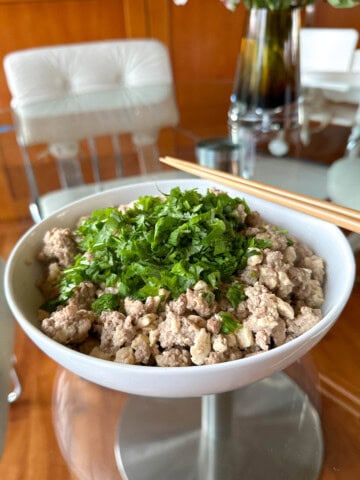
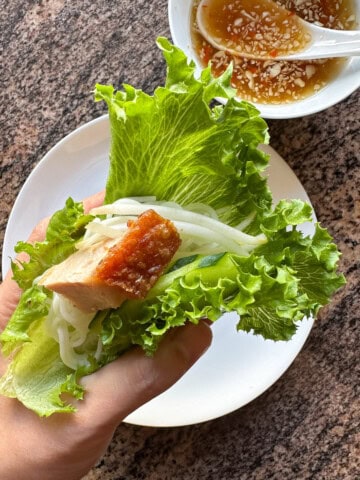
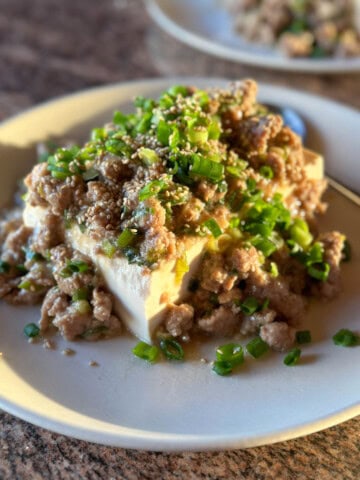
Kathy - Could you convert your recipe to cook in an Instant Pot? I love using mine (IP) because of the fast cooking times! Thank you.
Aloha Myra! Good idea! I love my IP as well heheh. Let me work on this, I'll update the post with instructions for making it in the Instant Pot 🙂
Kathy
Aloha Myra! I just updated the recipe card with Instant Pot instructions. Thank you and enjoy! ^_^
- Kathy
Stupid question: Should we drain the pork belly fat after browning?
Hi Kathy, I am also a Kathy, are you Uchinanchu? It looks so yummy!! Can't wait to make mine, do you think it throw off the flavor if I used wiskey? I don't have sake on hand right now.
@Kathy,
hey, that recipe for shoyu pork looks onolious...i will try it.
Can we leave out the sake or it won’t taste the same without it?
Aloha Meagan - It won't be quite the same (but still delicious!) without sake. You can also substitute Chinese rice wine or broth for the sake...neither are perfect substitutes but will work. Hope you enjoy! 🙂
- Kathy
@Meagan, it won't taste the same without it.
Do you take the skin off the pork belly or do you leave it on?
Hi Bert! Keep the skin on! 🙂 (Sometimes we can only find skin-off pork, but if you are lucky to get skin-on, definitely keep that skin on. It is delicious!)
Made this for dinner tonight with some small alterations because of isolation shortages. Served with fried tofu and rice. It was easy and delicious!! Definitely going to be a permanent addition to our dinner repertoire.
I told a friend about this dish and he made traditional rafute. He used the kokuto and awamori. I told him that is too much trouble and I just use brown sugar and sake. For me I also add raw peanuts (like when you make oxtail soup) since I like peanuts in this dish. I also put in cubes of daikon too! Kathy, you make a lot of dishes that I love.